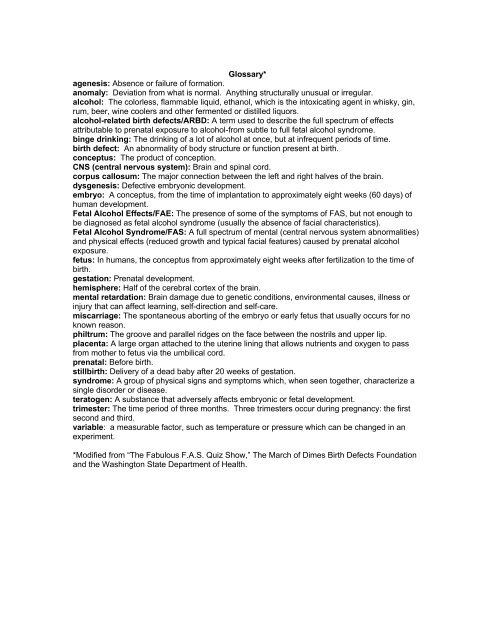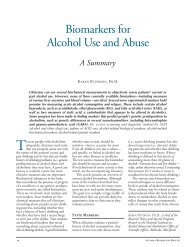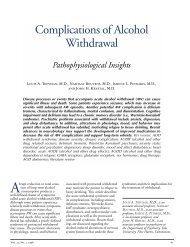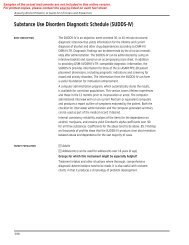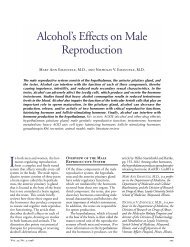Alcohol Syndrome (FAS) and Other Alcohol-Related Birth Defects
Alcohol Syndrome (FAS) and Other Alcohol-Related Birth Defects
Alcohol Syndrome (FAS) and Other Alcohol-Related Birth Defects
You also want an ePaper? Increase the reach of your titles
YUMPU automatically turns print PDFs into web optimized ePapers that Google loves.
Glossary*<br />
agenesis: Absence or failure of formation.<br />
anomaly: Deviation from what is normal. Anything structurally unusual or irregular.<br />
alcohol: The colorless, flammable liquid, ethanol, which is the intoxicating agent in whisky, gin,<br />
rum, beer, wine coolers <strong>and</strong> other fermented or distilled liquors.<br />
alcohol-related birth defects/ARBD: A term used to describe the full spectrum of effects<br />
attributable to prenatal exposure to alcohol-from subtle to full fetal alcohol syndrome.<br />
binge drinking: The drinking of a lot of alcohol at once, but at infrequent periods of time.<br />
birth defect: An abnormality of body structure or function present at birth.<br />
conceptus: The product of conception.<br />
CNS (central nervous system): Brain <strong>and</strong> spinal cord.<br />
corpus callosum: The major connection between the left <strong>and</strong> right halves of the brain.<br />
dysgenesis: Defective embryonic development.<br />
embryo: A conceptus, from the time of implantation to approximately eight weeks (60 days) of<br />
human development.<br />
Fetal <strong>Alcohol</strong> Effects/FAE: The presence of some of the symptoms of <strong>FAS</strong>, but not enough to<br />
be diagnosed as fetal alcohol syndrome (usually the absence of facial characteristics).<br />
Fetal <strong>Alcohol</strong> <strong>Syndrome</strong>/<strong>FAS</strong>: A full spectrum of mental (central nervous system abnormalities)<br />
<strong>and</strong> physical effects (reduced growth <strong>and</strong> typical facial features) caused by prenatal alcohol<br />
exposure.<br />
fetus: In humans, the conceptus from approximately eight weeks after fertilization to the time of<br />
birth.<br />
gestation: Prenatal development.<br />
hemisphere: Half of the cerebral cortex of the brain.<br />
mental retardation: Brain damage due to genetic conditions, environmental causes, illness or<br />
injury that can affect learning, self-direction <strong>and</strong> self-care.<br />
miscarriage: The spontaneous aborting of the embryo or early fetus that usually occurs for no<br />
known reason.<br />
philtrum: The groove <strong>and</strong> parallel ridges on the face between the nostrils <strong>and</strong> upper lip.<br />
placenta: A large organ attached to the uterine lining that allows nutrients <strong>and</strong> oxygen to pass<br />
from mother to fetus via the umbilical cord.<br />
prenatal: Before birth.<br />
stillbirth: Delivery of a dead baby after 20 weeks of gestation.<br />
syndrome: A group of physical signs <strong>and</strong> symptoms which, when seen together, characterize a<br />
single disorder or disease.<br />
teratogen: A substance that adversely affects embryonic or fetal development.<br />
trimester: The time period of three months. Three trimesters occur during pregnancy: the first<br />
second <strong>and</strong> third.<br />
variable: a measurable factor, such as temperature or pressure which can be changed in an<br />
experiment.<br />
*Modified from “The Fabulous F.A.S. Quiz Show,” The March of Dimes <strong>Birth</strong> <strong>Defects</strong> Foundation<br />
<strong>and</strong> the Washington State Department of Health.


